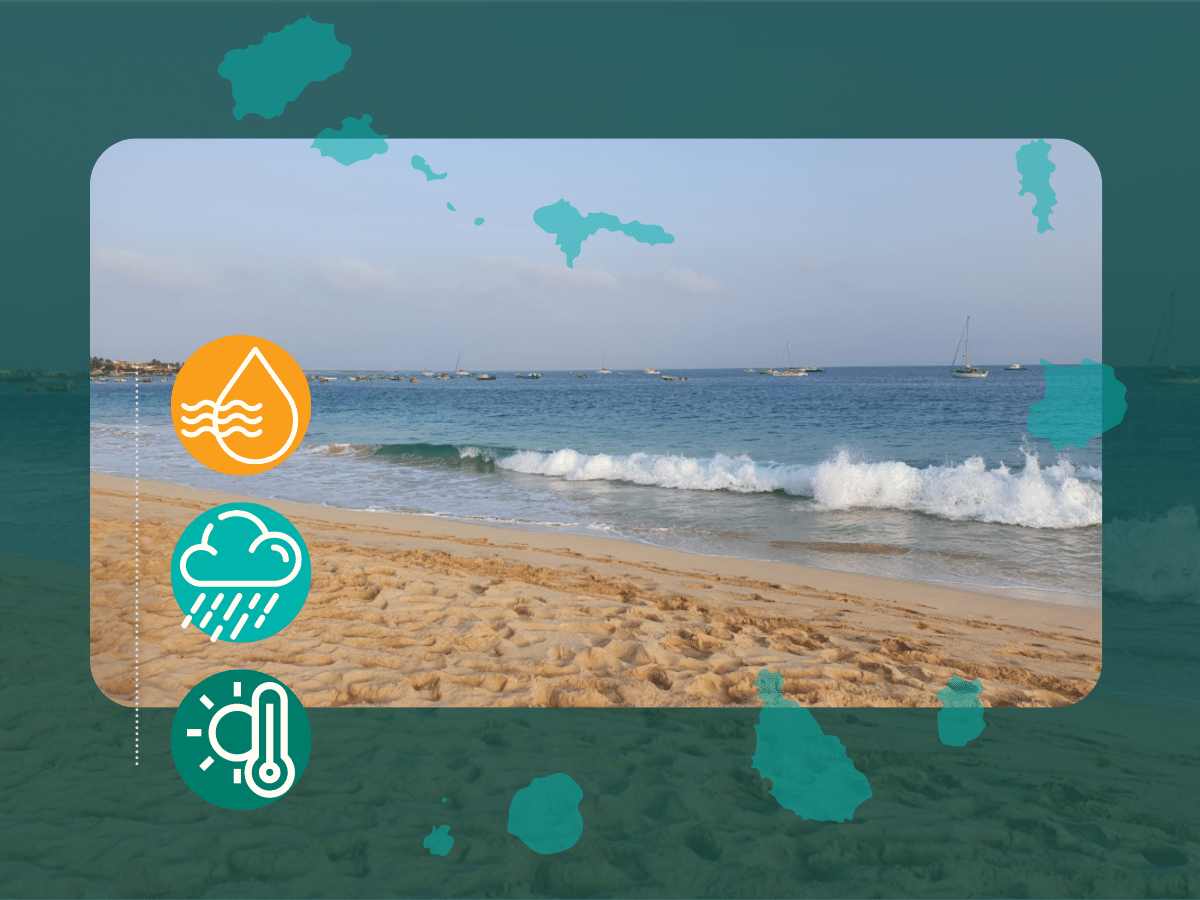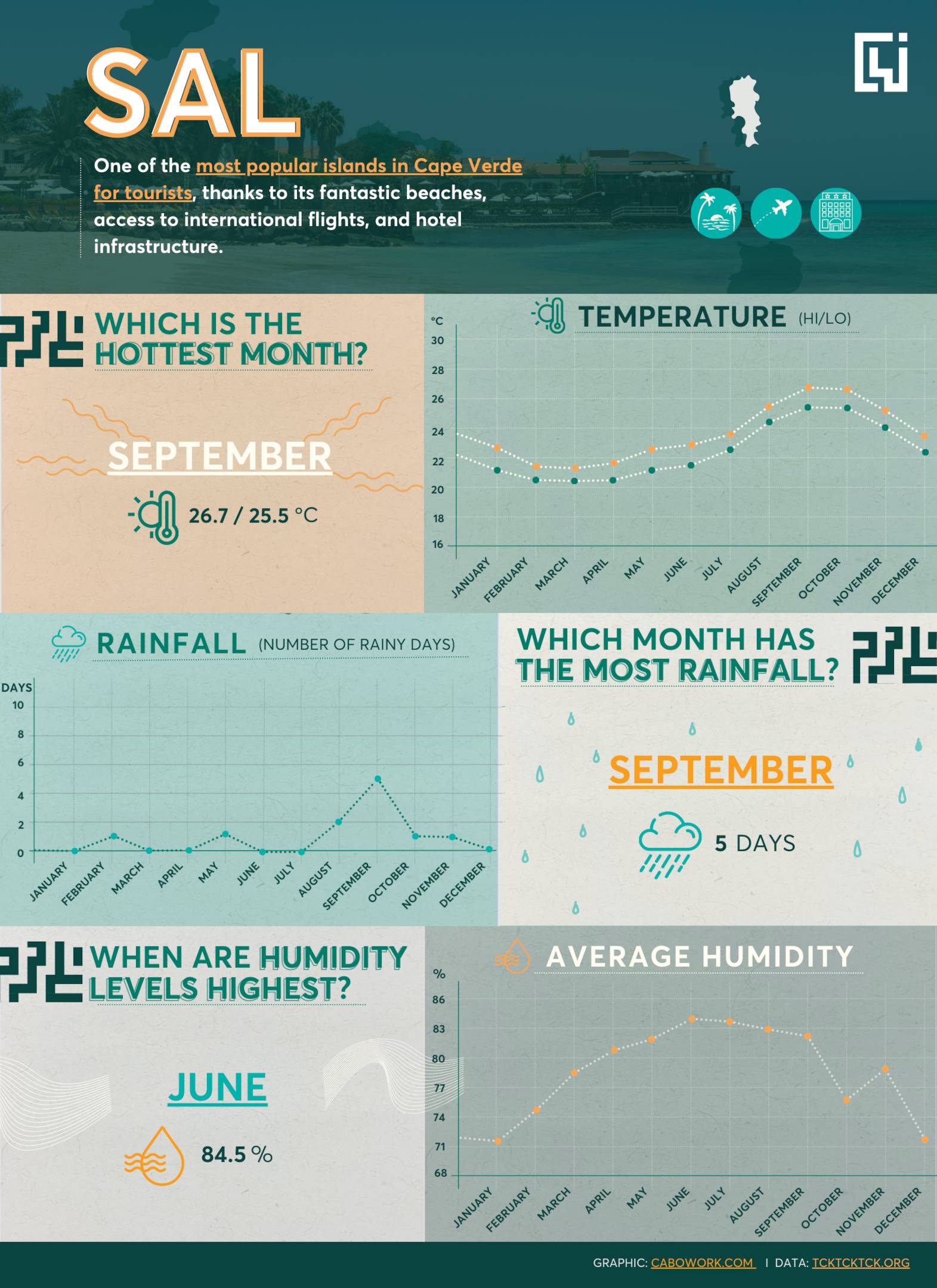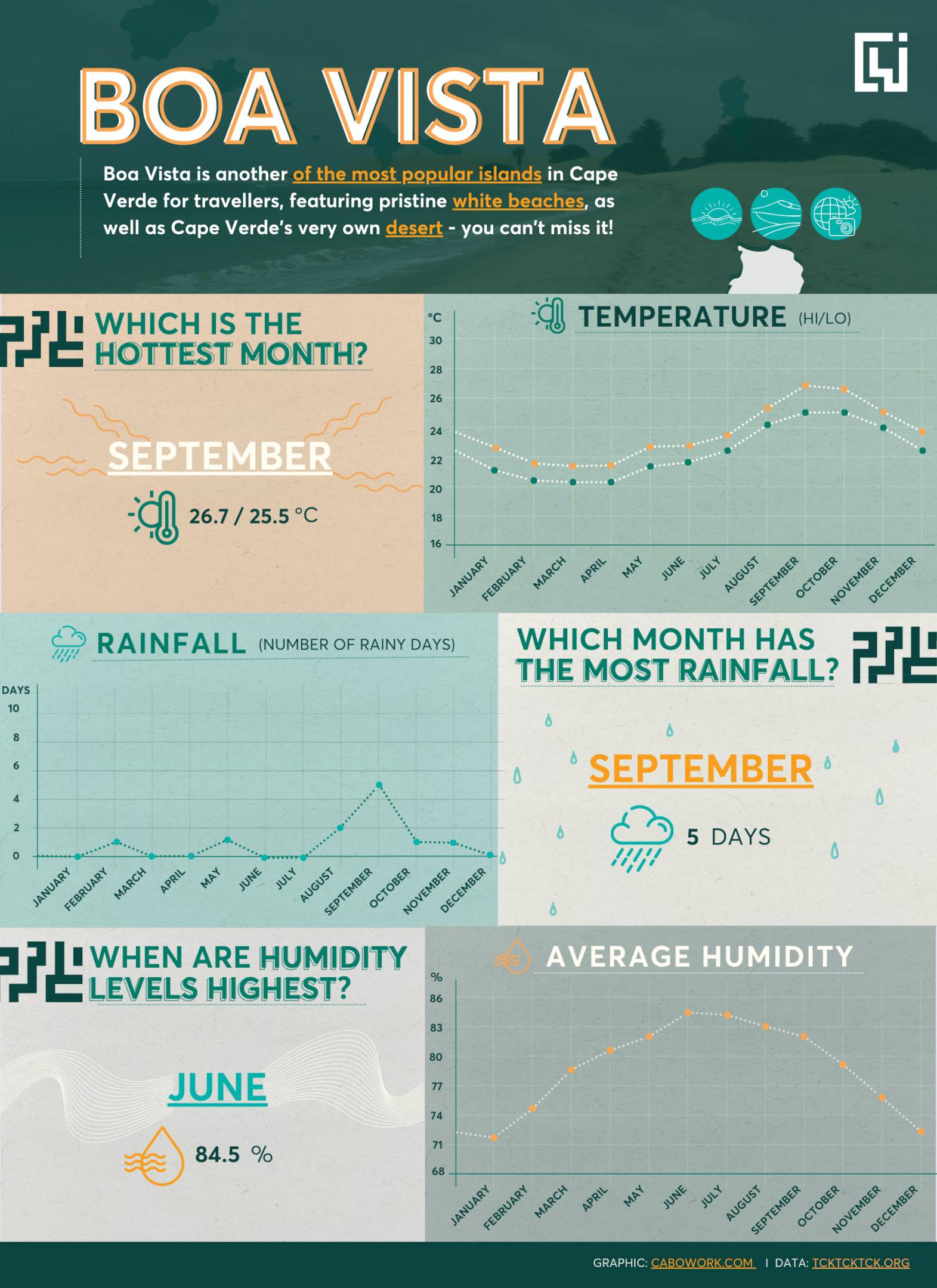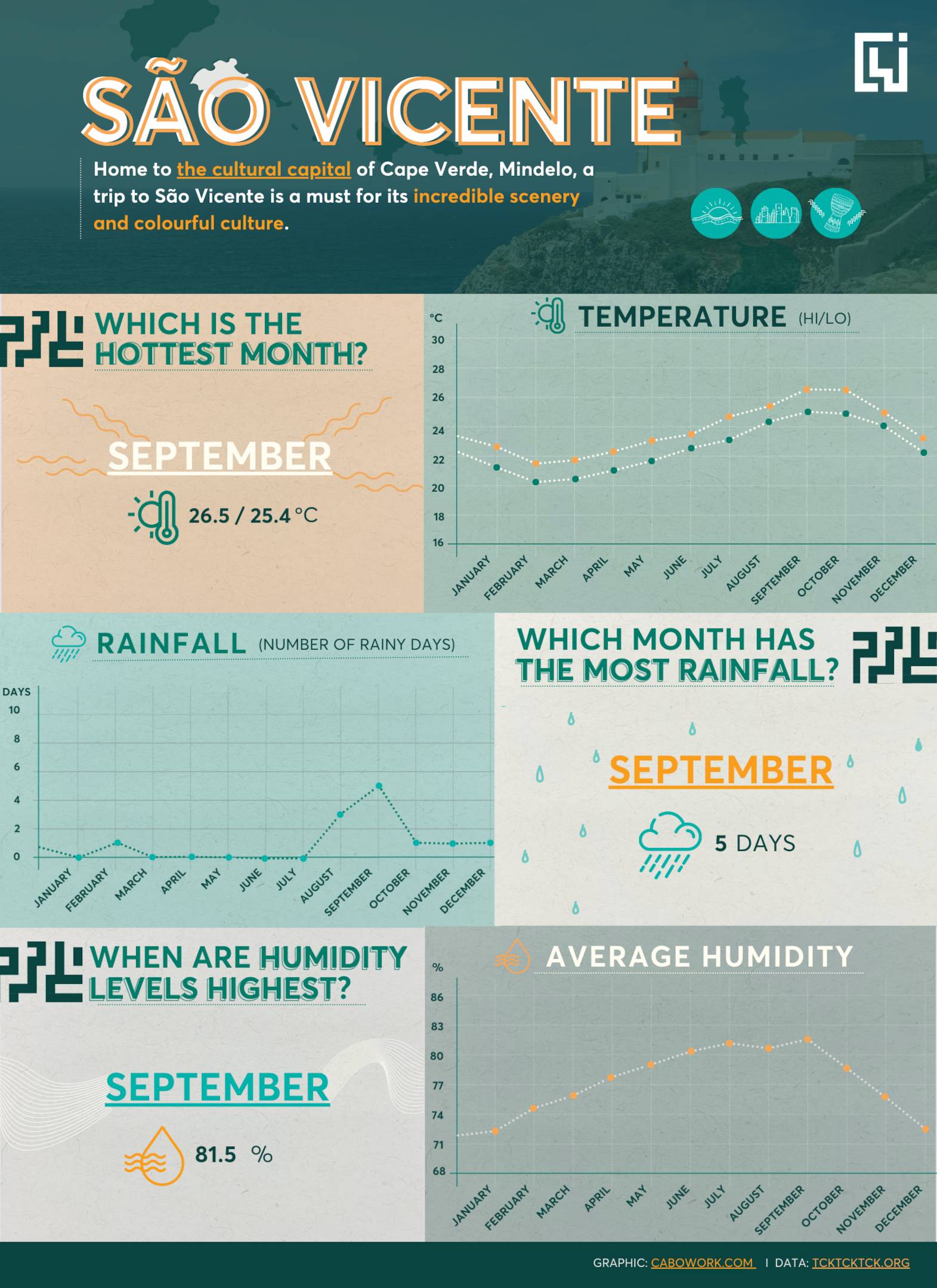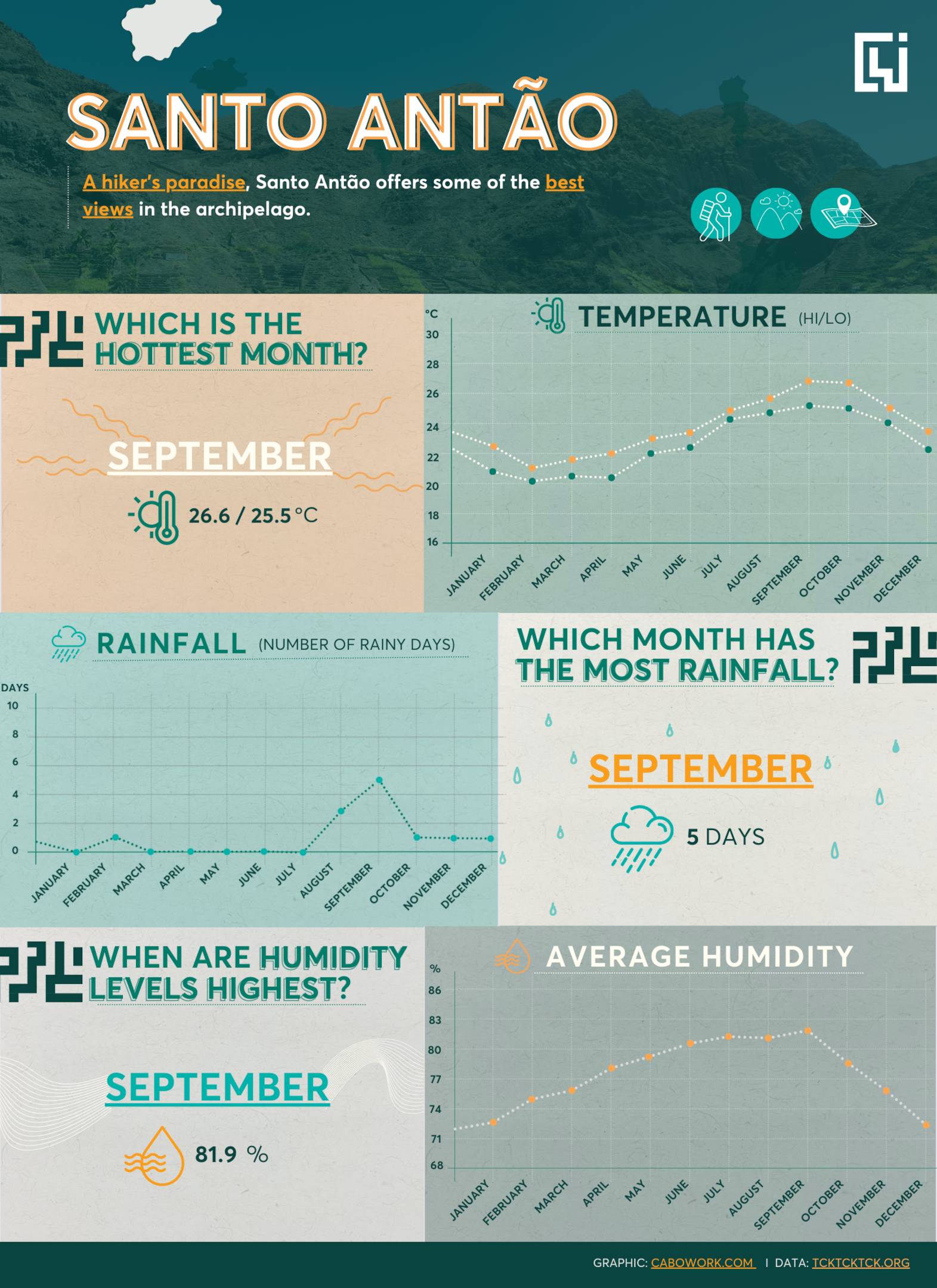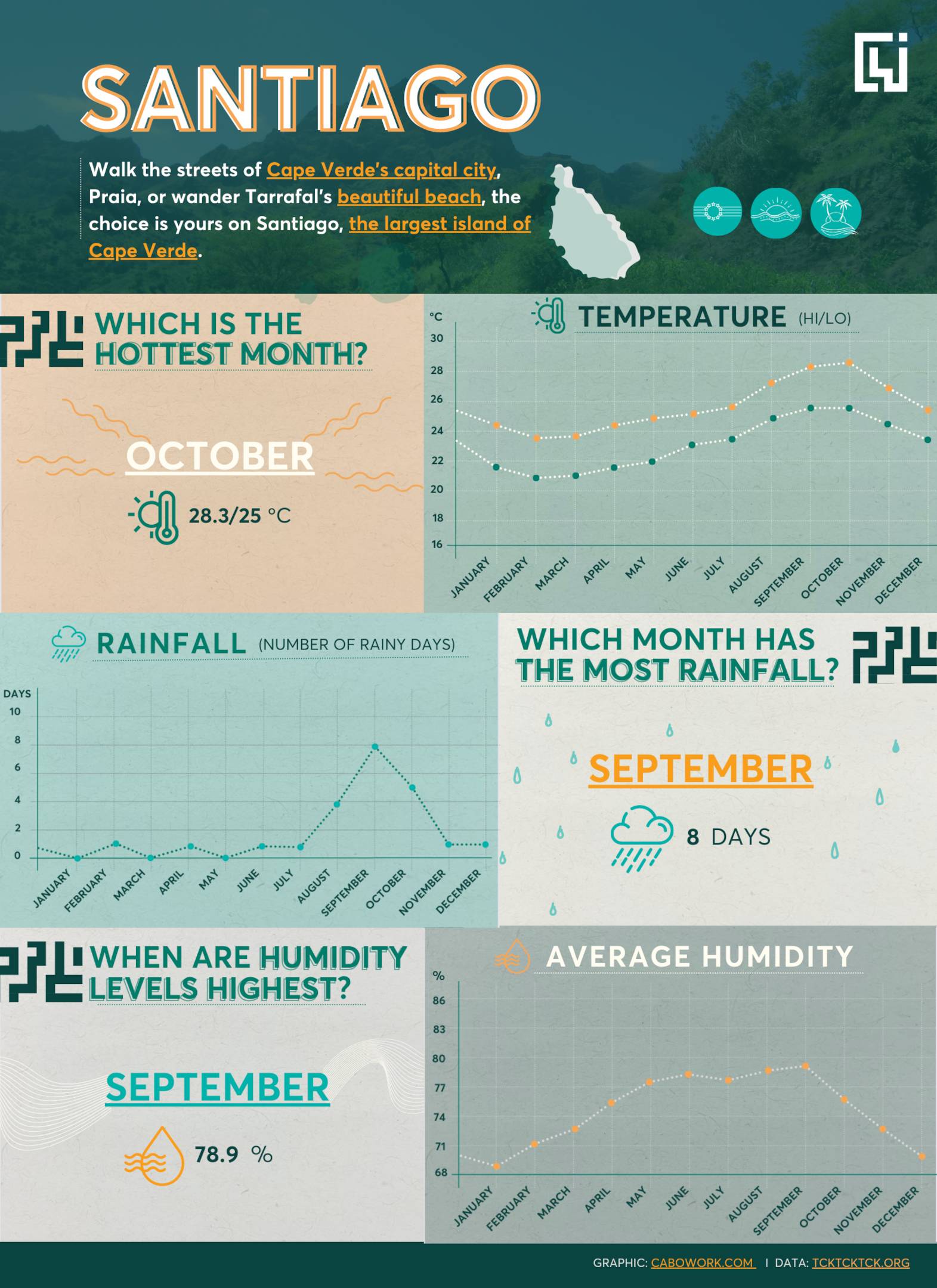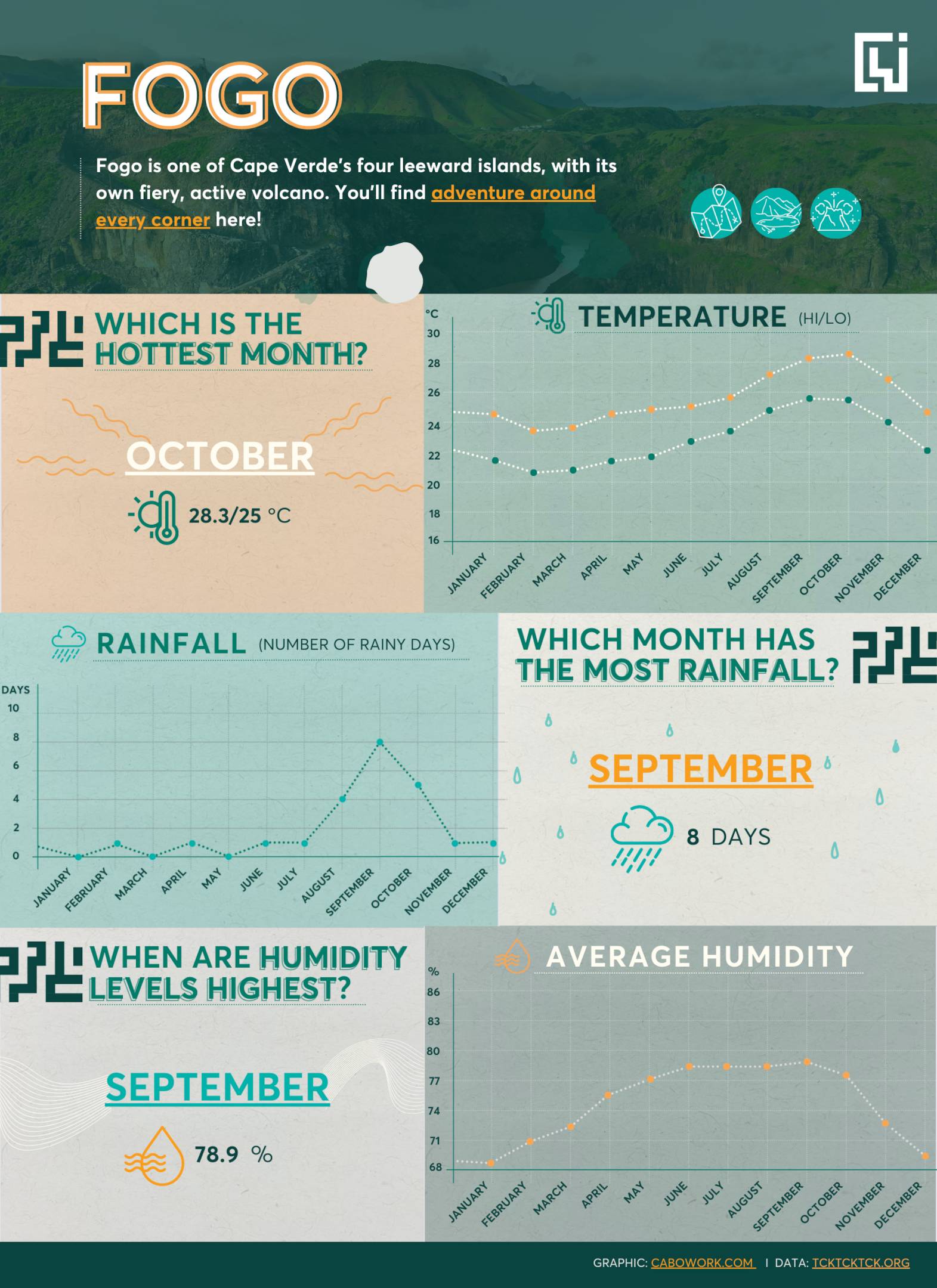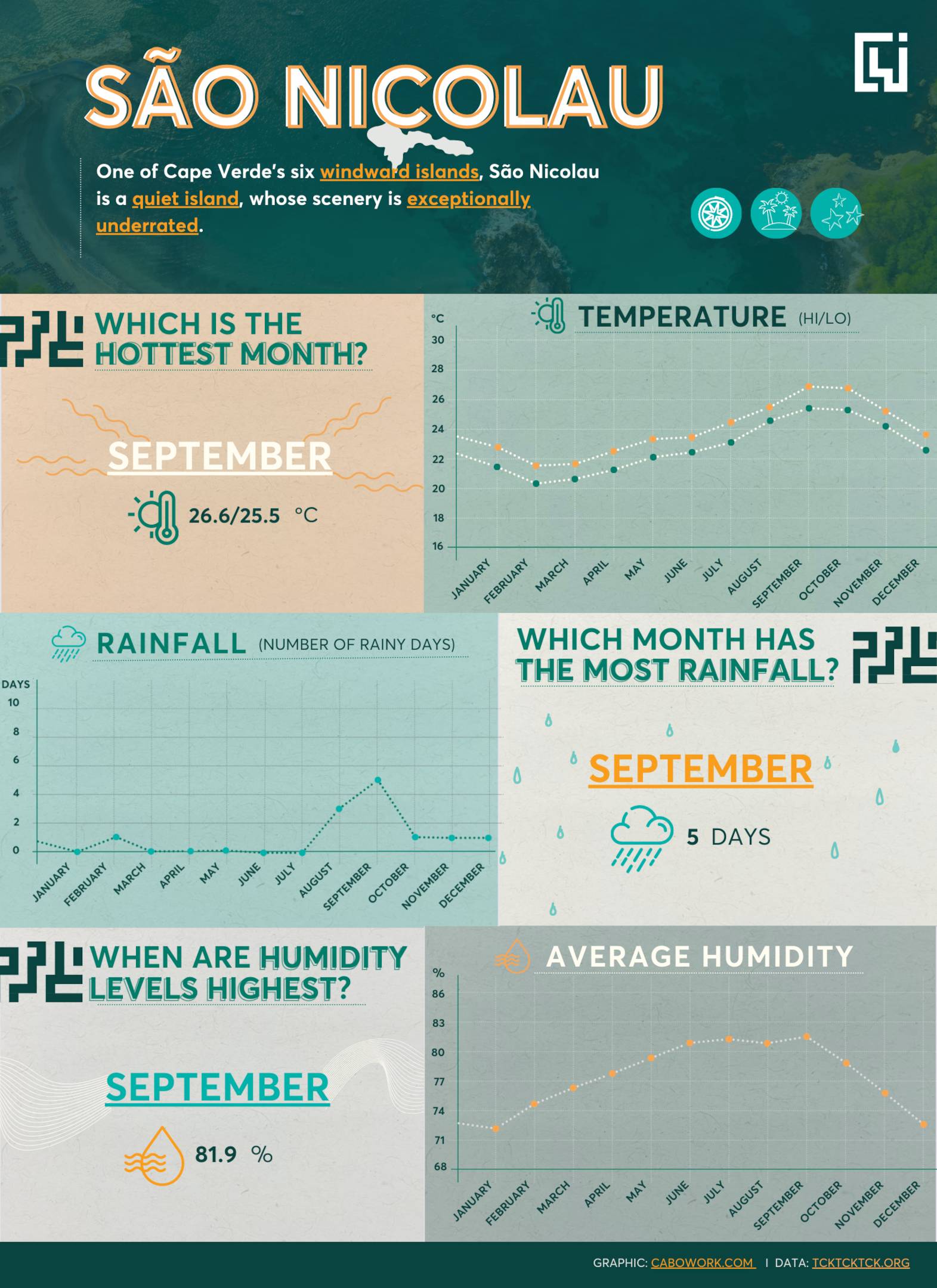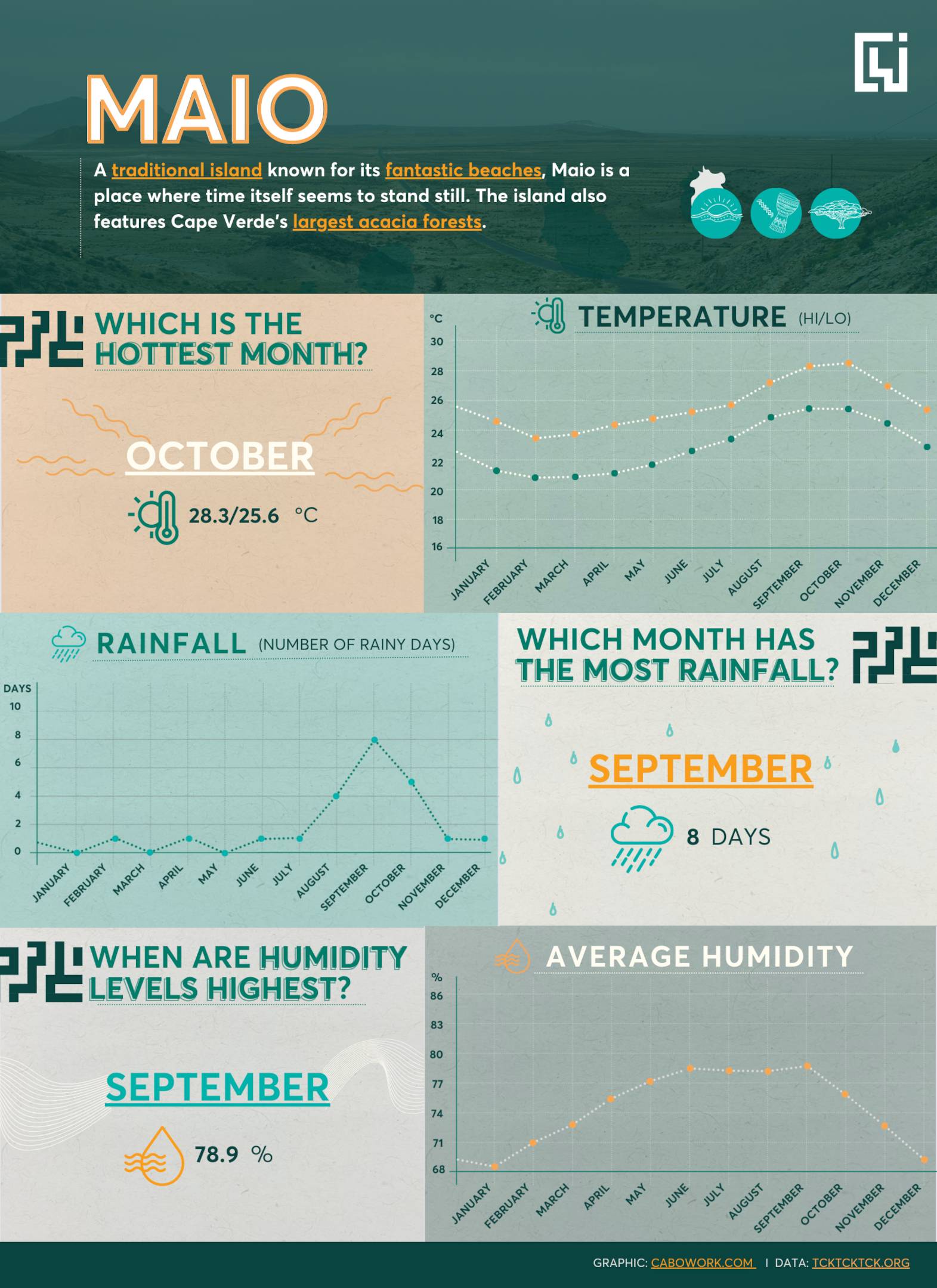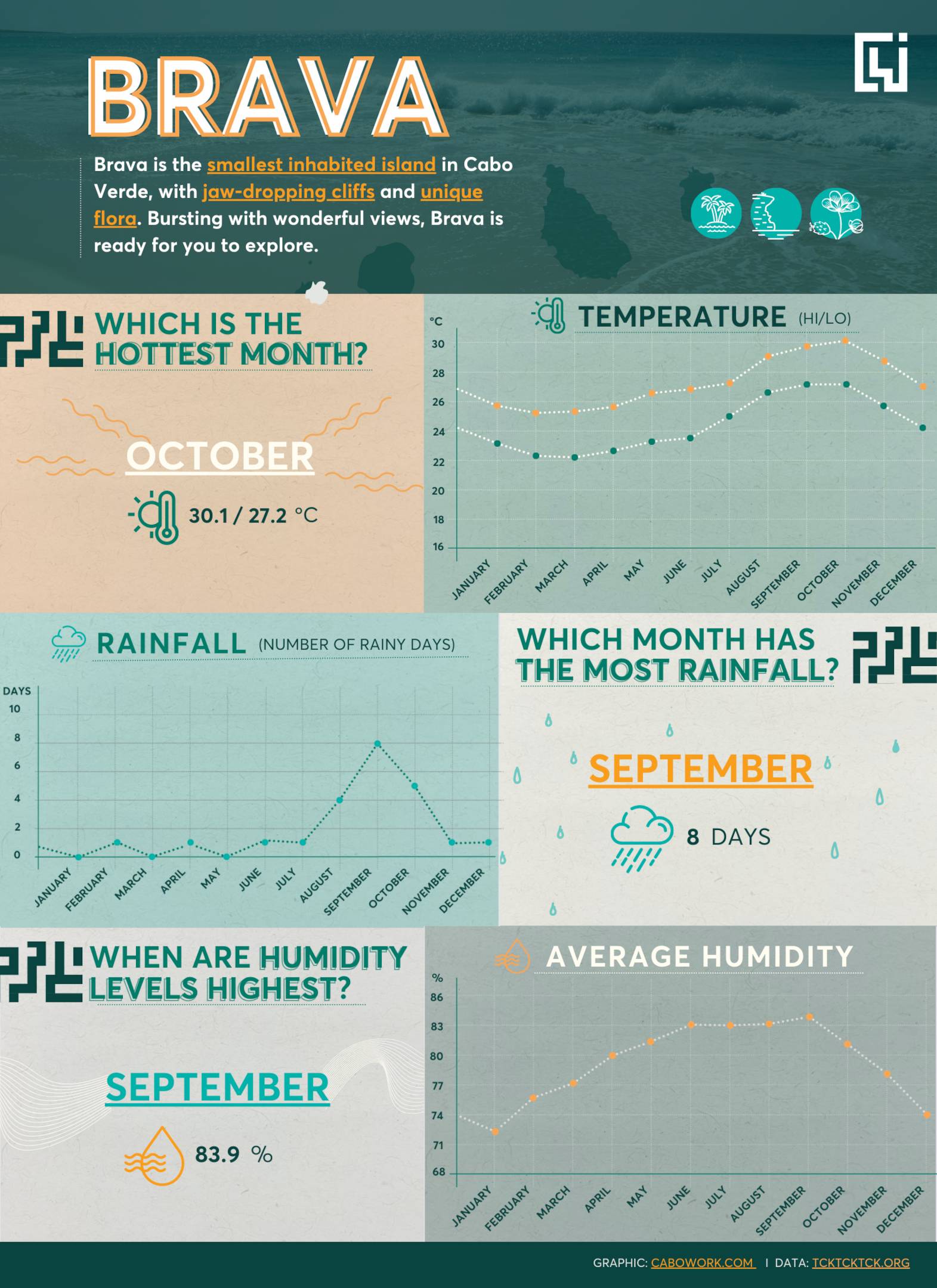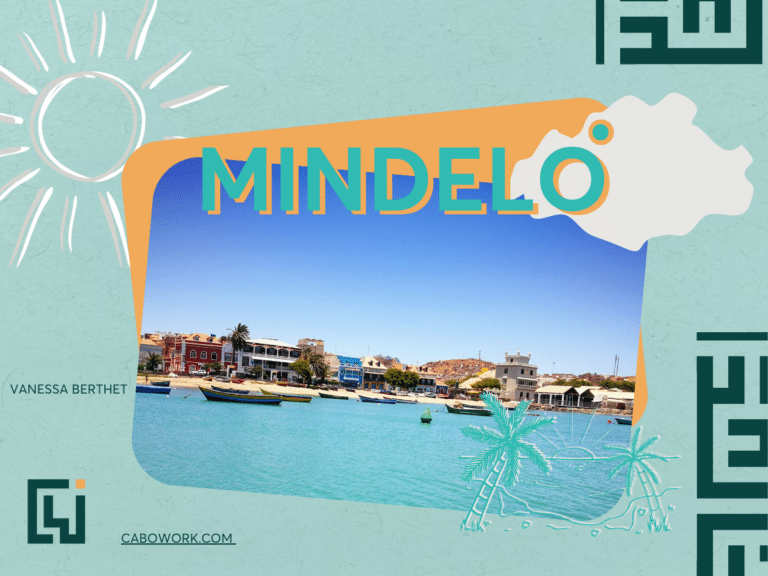Key Takeaways from this Article:
- Recommended months: October to May
- Ideal islands: Santo Antão, Santiago, Fogo
- Enjoy lush mountains and volcanic landscapes on these islands during the dry and comfortable months for hiking.
- Generally favourable year-round weather in Cape Verde.
- The dry tropical climate ensures low humidity and minimal rainfall for most of the year.
- However outdoor humidity is at its highest in July, August, and September.
- Consider shoulder seasons (outside of peak tourism) for a quieter experience, such as October and May.
- Cape Verde offers good conditions for swimming year-round, thanks to warm temperatures.
- Windier periods may affect swimming in some areas, but there are still great spots to enjoy the sea.
- Be careful to make sure conditions are safe before entering the water. Cape Verde experiences strong currents, so it’s important to only swim where you know it’s safe.
- Sal is our favourite island for swimming and beach activities.
- Occurs from late July to September/beginning of October.
- Humidity rises during this time, and activities like hiking may be more challenging.
- The highest average rainfall is in September, with 5 to 8 rainy days on average across the islands.
Your Guide to Cape Verde Weather
The average temperature on the Cape Verde Islands ranges from 20 to 29 °C throughout the year.
Although each of the ten islands enjoys pleasant temperatures year-round, the weather can vary slightly depending on which islands you are visiting.
In our complete Cape Verde weather guide, we’ve broken down the average temperatures throughout the year for the 9 inhabited islands. To help you plan your special trip, we have also included the best times to visit for outdoor activities. Read on to find out more!
Weather data courtesy of https://tcktcktck.org/.
Fun Fact: Did you know that Santa Luzia is Cape Verde’s only uninhabited island?
What's the Weather Like in Sal?
Sal island is the most popular destination for international tourists, home to fantastic sandy beaches and the perfect weather for outdoor activities.
Walk the streets of Santa Maria or take a stroll along Kite Beach, there’s plenty to see and do on this welcoming island!
Sal weather summary:
· The temperature is generally very consistent throughout the year, with it being warmest in September (26.7 °C) and temperatures at their lowest in February (20.5 °C).
· Throughout most of the year, rainfall is extremely low. Rainy days peak in September (5 rainy days on average).
· Humidity hits its highest level in June (84.5%) and the lowest in January (71.4%).
What's the Weather Like in Boa Vista?
The island of Boa Vista is home to Cape Verde’s very own desert, as well as the stunning Santa Monica beach. If you have the time to go island hopping, we truly recommend taking a flight or ferry to this beautiful island.
Sal Rei is the largest and most popular city in Boa Vista.
Boa Vista weather summary:
Boa Vista enjoys similar temperatures and weather patterns to Sal, with it being warmest in September (26.7 °C) and temperatures at their lowest in February (20.5 °C).
Rainfall is also very similar to Sal, with rainy days peaking in September (5 rainy days on average).
Humidity levels hit their highest in June (84.5%) and their lowest in January (71.4%).
What's the Weather Like in São Vicente?
There’s a good reason why Mindelo, the capital city of São Vicente, is the cultural heart of Cape Verde. Take one step down the cobbled streets, and you’ll see bustling cafés, restaurants, and a host of shops to explore.
São Vicente weather summary:
São Vicente is one of Cape Verde’s barlavento islands, the northern group of Cape Verde’s islands, with temperatures reaching their highest in September (26.5 °C) and their lowest in February (20.1 °C).
As is common throughout the archipelago, the island sees very little rainfall, peaking in September (5 rainy days on average) and at its lowest from March to July (0 rainy days on average).
Humidity in São Vicente hits its highest level in September (81.5%) and its lowest in January (72%).
What's the Weather Like in Santo Antão?
Santo Antão is a hiker’s paradise, there’s no doubt about it! With its dramatic, mountainous landscape, you’ll feel at one with nature while walking the many trails to be found.
Santo Antão weather summary:
Temperatures in Santo Antão reach their highest in September (26.7 °C) and reach their lowest in February (20.2 °C).
September sees the most rainfall, with 5 rainy days on average. From March to July there is the least amount of rain (0 rainy days on average).
Humidity levels in Santo Antão are at their highest in September (81.9%) and are lowest in January (72.3%).
The temperatures between the coastal towns and the higher plains can vary greatly
What's the Weather Like in Santiago?
Despite being Cape Verde’s largest and most populated island, Santiago often flies under the radar for most tourists visiting the archipelago. Which is a shame, as there’s so much to see and do!
From the majestic mountains to the busy streets of Praia, there’s something for every type of traveller in Santiago.
Santiago weather summary:
Santiago enjoys a dry tropical climate throughout the year. The weather is hottest during October (28.3 °C) and coolest during February (20.8 °C).
The island also sees some of Cape Verde’s highest rates of rainfall, with an average of 8 rainy days in September.
Humidity can also be quite high especially in September (78.9%). It is lowest in January (72.3%).
What's the Weather Like in Fogo?
How would you like to play with fire? Well, the island of Fogo is named after Pico do Fogo, Cape Verde’s active volcano!
Offering stunning views and a breathtaking (literally!) trail, don’t let Fogo’s ‘remoteness’ put you off, it’s only a 30-minute plane journey from Praia.
Fogo weather summary:
Fogo’s hottest temperatures occur during October (28.3 °C). Its coolest month is February (20.8 °C).
Rainfall is highest in September (8 rainy days average), and lowest between January and May (0 rainy days average).
Humidity is highest in September (78.9%) and lowest in January (68.4%).
The temperatures in the Caldeira can be very fresh, especially if you set off for the hike up Pico do Fogo before sunrise.
What's the Weather Like in São Nicolau?
São Nicolau is much like Santo Antão, offering a sense of peace and tranquillity with its impressive, mountainous scenery and hiking routes.
This island is perfect for an island hopping holiday, or as a retreat from the more touristic islands during peak season.
São Nicolau weather summary:
The weather is hottest during September (26.6 °C) and coolest during February (20.2 °C).
September also sees the most rainy days, with 5 rainy days on average. São Nicolau’s driest months are January through to July, excluding February.
São Nicolau’s highest levels of humidity occur in September (81.9%) and it is the least humid in January (72.3%).
What's the Weather Like in Maio?
With a population of fewer than 10,000 people, the sleepy but beautiful island of Maio is also quite untouched by tourism. Around 20% of the island is heavily forested, where lush acacia trees can be found.
A flight from Santiago to Maio takes 17 minutes on average.
Maio weather summary:
Temperatures are highest in Maio in October (28.3 °C) and are at their lowest in February (20.8 °C).
You’ll find the most rain in Maio during September (8 rainy days on average) and the least rainfall occurring during January and March (0 rainy days on average).
Humidity levels in Maio peak in September (78.9%) and reach their lowest point in January (68.4%).
What's the Weather Like in Brava?
Brava is the smallest inhabited island in Cape Verde at 67 square kilometres – but that doesn’t mean you should let an opportunity to visit pass you by!
We highly recommend walking up Fontainhas, where you can enjoy a spectacular panoramic view of the island.
Brava weather summary:
Brava enjoys warm temperatures throughout the year, with temperatures at their highest point in October (30.1 °C) and at their lowest in March (22.1 °C).
September sees the most rain, with 8 rainy days on average. January, March, and May see 0 rainy days on average.
Humidity is highest in September (83.9%) and lowest in January (72.7%).
The Seasons in Cape Verde
Rather than having the traditional four seasons, Cape Verde enjoys only two – the rainy and windy seasons.
Free of the cold European winter season, travellers can make the most of the dry tropical climate as the winds blow across the Atlantic Ocean. The result? Low humidity with very little rainfall.
The rainy season takes place between the months of late July to September/beginning of October, when humidity rises and activities such as hiking become more difficult.
Daylight hours remain consistent throughout the year, average sunshine hours decrease between July and September due to cloud cover from the rainy season.
When to Try Activities in Cape Verde
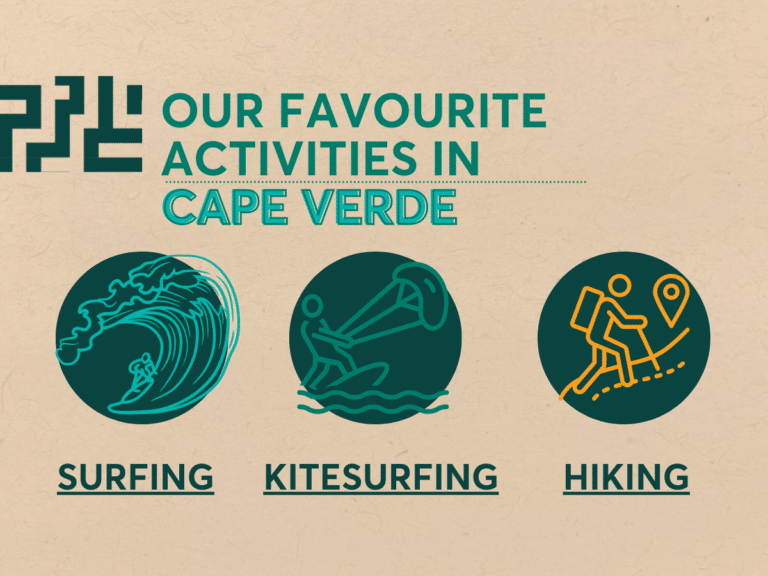
From kitesurfing to hiking, Cape Verde’s weather is perfect for enjoying outdoor activities. We’ve selected some of the most popular activities, giving you recommendations on which islands to visit, as well as the best time to visit.
Get stuck into our complete Cape Verde activity guide to learn more!
Go Surfing
You don’t need golden flowing hair to enjoy time out surfing – there are plenty of fantastic spots to catch a wave, for both beginner and advanced surfers alike.
Best islands to visit for surfing:
Sal/Boa Vista
Best time to visit for surfing:
November to March (although good spots can still be found year-round)
Try out Kitesurfing
Although it can be difficult to swim in the sea in some areas, thanks to the higher winds, this makes Cape Verde the perfect destination to go kitesurfing. If you’ve ever wanted to try your hand at this adrenaline-fuelling activity, now’s your chance!
Best islands to visit for kitesurfing:
Boa Vista/Sal
Best time to visit for kitesurfing:
December to March
Give hiking a go
Beyond the sunny and popular shores of Sal island, you’ll find countless underrated hiking routes. From lush mountains to a rocky volcano, exploring the islands by foot will make for a truly memorable experience.
Best islands to visit for hiking:
Santo Antão/Santiago/Fogo
Best time to visit for hiking:
October to May
Discover 9 of our favourite hiking trails in our Cape Verde hiking guide.
